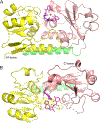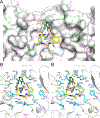Crystal Structure of the Siderophore Binding Protein BauB Bound to an Unusual 2:1 Complex Between Acinetobactin and Ferric Iron
- PMID: 30406986
- PMCID: PMC6474793
- DOI: 10.1021/acs.biochem.8b00986
Crystal Structure of the Siderophore Binding Protein BauB Bound to an Unusual 2:1 Complex Between Acinetobactin and Ferric Iron
Abstract
The critical role that iron plays in many biochemical processes has led to an elaborate battle between bacterial pathogens and their hosts to acquire and withhold this critical nutrient. Exploitation of iron nutritional immunity is being increasingly appreciated as a potential antivirulence therapeutic strategy, especially against problematic multidrug resistant Gram-negative pathogens such as Acinetobacter baumannii. To facilitate iron uptake and promote growth, A. baumannii produces a nonribosomally synthesized peptide siderophore called acinetobactin. Acinetobactin is unusual in that it is first biosynthesized in an oxazoline form called preacinetobactin that spontaneously isomerizes to the final isoxazolidinone acinetobactin. Interestingly, both isomers can bind iron and both support growth of A. baumannii. To address how the two isomers chelate their ferric cargo and how the complexes are used by A. baumannii, structural studies were carried out with the ferric acinetobactin complex and its periplasmic siderophore binding protein BauB. Herein, we present the crystal structure of BauB bound to a bis-tridentate (Fe3+L2) siderophore complex. Additionally, we present binding studies that show multiple variants of acinetobactin bind BauB with no apparent change in affinity. These results are consistent with the structural model that depicts few direct polar interactions between BauB and the acinetobactin backbone. This structural and functional characterization of acinetobactin and its requisite binding protein BauB provides insight that could be exploited to target this critical iron acquisition system and provide a novel approach to treat infections caused by this important multidrug resistant pathogen.
Figures




Similar articles
-
Fimsbactin and Acinetobactin Compete for the Periplasmic Siderophore Binding Protein BauB in Pathogenic Acinetobacter baumannii.ACS Chem Biol. 2019 Apr 19;14(4):674-687. doi: 10.1021/acschembio.8b01051. Epub 2019 Mar 8. ACS Chem Biol. 2019. PMID: 30785725
-
Distinctive Roles of Two Acinetobactin Isomers in Challenging Host Nutritional Immunity.mBio. 2021 Oct 26;12(5):e0224821. doi: 10.1128/mBio.02248-21. Epub 2021 Sep 14. mBio. 2021. PMID: 34517755 Free PMC article.
-
Acinetobactin Isomerization Enables Adaptive Iron Acquisition in Acinetobacter baumannii through pH-Triggered Siderophore Swapping.ACS Infect Dis. 2016 Feb 12;2(2):157-68. doi: 10.1021/acsinfecdis.5b00145. Epub 2015 Dec 23. ACS Infect Dis. 2016. PMID: 27624967
-
Current biochemical understanding regarding the metabolism of acinetobactin, the major siderophore of the human pathogen Acinetobacter baumannii, and outlook for discovery of novel anti-infectious agents based thereon.Nat Prod Rep. 2020 Apr 1;37(4):477-487. doi: 10.1039/c9np00046a. Epub 2019 Oct 29. Nat Prod Rep. 2020. PMID: 31661538 Review.
-
Iron acquisition functions expressed by the human pathogen Acinetobacter baumannii.Biometals. 2009 Feb;22(1):23-32. doi: 10.1007/s10534-008-9202-3. Epub 2009 Jan 7. Biometals. 2009. PMID: 19130255 Review.
Cited by
-
Location, Location, Location: Establishing Design Principles for New Antibacterials from Ferric Siderophore Transport Systems.Molecules. 2024 Aug 16;29(16):3889. doi: 10.3390/molecules29163889. Molecules. 2024. PMID: 39202968 Free PMC article. Review.
-
Iron Acquisition by Bacterial Pathogens: Beyond Tris-Catecholate Complexes.Chembiochem. 2020 Jul 16;21(14):1955-1967. doi: 10.1002/cbic.201900778. Epub 2020 Apr 14. Chembiochem. 2020. PMID: 32180318 Free PMC article. Review.
-
Comparative genome analyses of Mycobacteroides immunogenum reveals two potential novel subspecies.Microb Genom. 2020 Dec;6(12):mgen000495. doi: 10.1099/mgen.0.000495. Epub 2020 Dec 9. Microb Genom. 2020. PMID: 33295861 Free PMC article.
-
Carbapenemases: Transforming Acinetobacter baumannii into a Yet More Dangerous Menace.Biomolecules. 2020 May 6;10(5):720. doi: 10.3390/biom10050720. Biomolecules. 2020. PMID: 32384624 Free PMC article. Review.
-
Iron Acquisition Systems of Gram-negative Bacterial Pathogens Define TonB-Dependent Pathways to Novel Antibiotics.Chem Rev. 2021 May 12;121(9):5193-5239. doi: 10.1021/acs.chemrev.0c01005. Epub 2021 Mar 16. Chem Rev. 2021. PMID: 33724814 Free PMC article. Review.
References
-
- Hider RC, and Kong X (2010) Chemistry and biology of siderophores, Nat Prod Rep 27, 637–657. - PubMed
-
- Bilitewski U, Blodgett JAV, Duhme-Klair AK, Dallavalle S, Laschat S, Routledge A, and Schobert R (2017) Chemical and biological aspects of nutritional immunity-perspectives for new anti-infectives that target iron uptake systems, Angew Chem Int Ed Engl 56, 14360–14382. - PubMed
Publication types
MeSH terms
Substances
Grants and funding
LinkOut - more resources
Full Text Sources
Medical
Molecular Biology Databases
Miscellaneous

